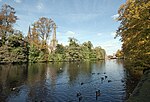Hospital of St John Baptist without the Barrs
AC with 0 elementsAlmshouses in StaffordshireBuildings and structures in LichfieldGrade I listed almshousesGrade I listed buildings in Staffordshire ... and 1 more
Hospitals in Staffordshire

The Hospital of St John Baptist without the Barrs is a building with an adjacent chapel in the city of Lichfield, Staffordshire, England. It is a Grade I listed building.The building has ancient roots, once providing accommodation to travellers outside the southern city walls who would arrive in Lichfield after the gates had closed for the night. The distinctive eight chimneys fronting St John's Street date back to the Tudor period when the hospital served as an almshouse for elderly gentlemen in the city.
Excerpt from the Wikipedia article Hospital of St John Baptist without the Barrs (License: CC BY-SA 3.0, Authors, Images).Hospital of St John Baptist without the Barrs
St John Street, Lichfield Darwin Park
Geographical coordinates (GPS) Address Nearby Places Show on map
Geographical coordinates (GPS)
| Latitude | Longitude |
|---|---|
| N 52.6801 ° | E -1.8274 ° |
Address
St John Street
St John Street
WS14 4SB Lichfield, Darwin Park
England, United Kingdom
Open on Google Maps










